Spicy, savoury, and utterly moreish-this One Pot Chicken Kimchi Rice is a weeknight winner with bold, punchy flavour and minimal fuss. Tender chicken thighs simmer gently with tangy kimchi and a touch of sweetness, creating a rich, satisfying dish that brings comforting Korean-inspired vibes to your dinner table.
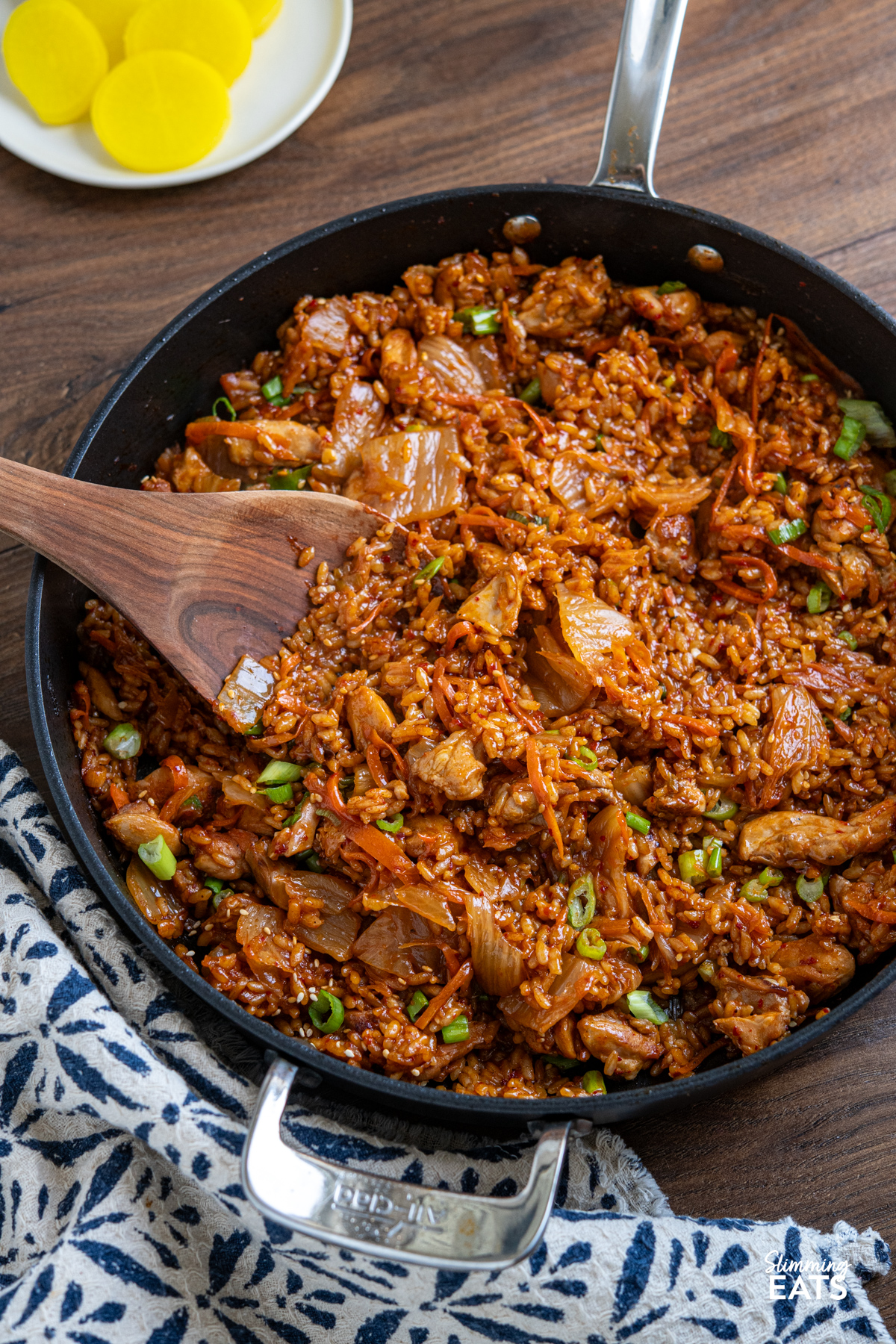
It's a saucy twist on fried rice, all cooked in one pot for ease. Perfect on its own, but even better with a fried egg on top-the runny yolk mixes through and adds an extra layer of richness to every bite.
Calories in One Pot Chicken Kimchi Rice
This recipe serves 4 and is 423 calories per serving
If you're looking for more recipes within the same calorie range, you'll find an abundance of options in my dedicated collection of 400+ calorie recipes.
If you're following a calorie-controlled diet or a healthy eating plan, it's important to calculate your daily calorie intake using a reliable calorie calculator. Please note that the calorie counts provided are estimates and can vary based on specific ingredients and serving sizes. Personalizing your calculations is essential to meet your individual needs. By using a calorie calculator, you can make informed choices and stay on track with your dietary goals.
See the recipe card for full nutritional estimation.
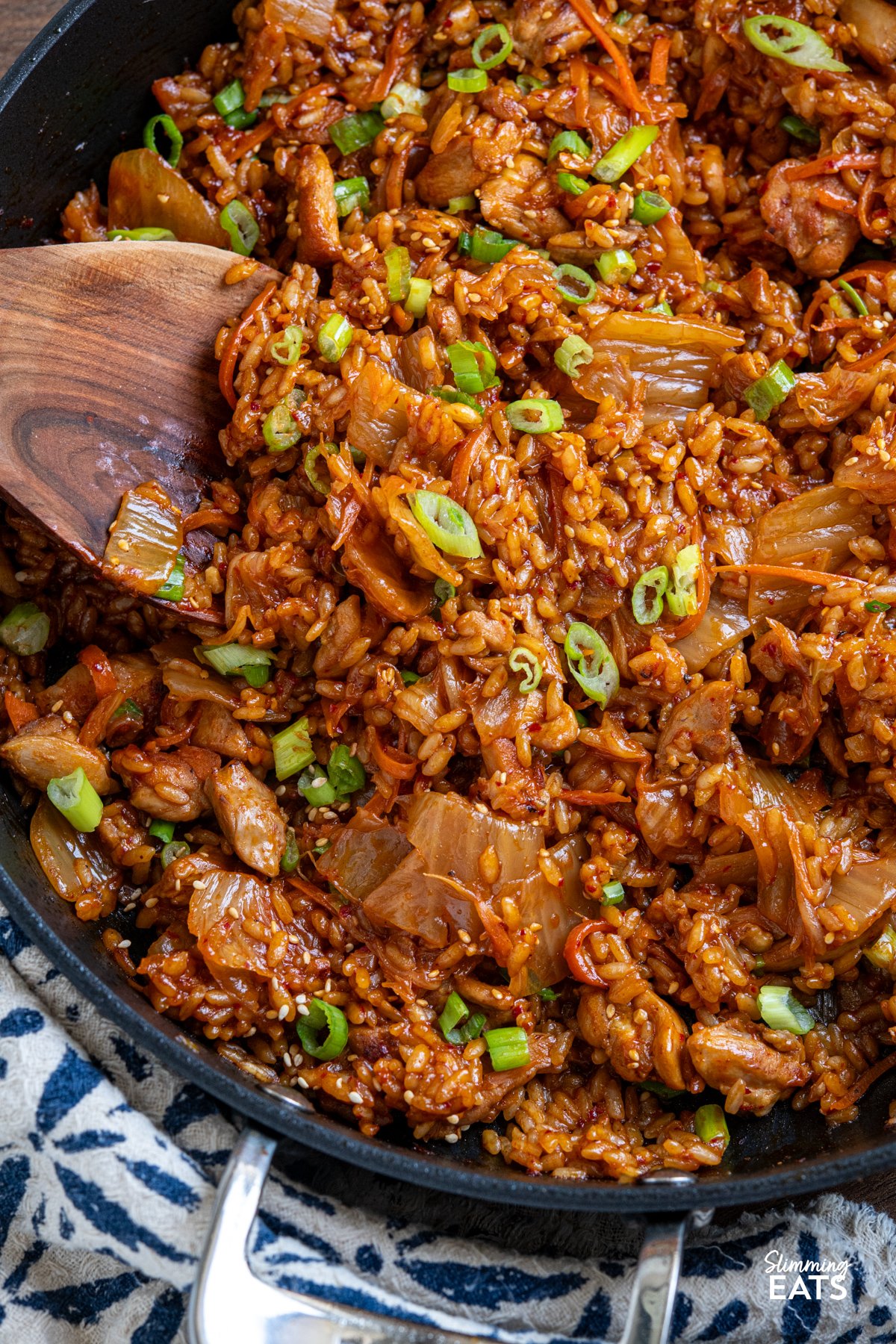
Ingredients Notes
To make this recipe you will need the following ingredients:
- Boneless (skinless) chicken thighs - Juicy and full of flavour, thighs hold up well to simmering and stay tender in the sauce. You can swap for breast if you prefer, but it won't be quite as rich.
- Spring onions - Added at the end for a fresh, mild onion flavour and a bit of colour. They help lift the dish and balance the richness.
- Kimchi - This is where the bold flavour comes in. Store-bought is totally fine, but if you can't get hold of any, try my quick fresh kimchi recipe instead. Just note it won't bring that signature fermented tang.
- Gochujang - A Korean chilli paste that adds warmth, depth, and umami without being too hot. It's the key to that spicy-savoury base.
- Maple syrup - Just a touch to mellow out the spice and acidity. You can swap for honey if that's what you've got.
- Soy sauce - Adds saltiness and umami. Regular light soy works best-low sodium versions won't give the same depth.
- Sesame oil - A drizzle at the end adds a lovely toasty, nutty finish. It's strong, so a little really does go a long way.
- Carrot - Adds subtle sweetness and a bit of texture. It softens as it cooks but still keeps a slight bite.
- Garlic - A must for boosting flavour-it pairs beautifully with the gochujang and helps build the base of the dish.
- Salt and pepper - Light seasoning to bring it all together. Be cautious with salt, as the soy sauce and kimchi already bring plenty.
- Chicken stock - Helps cook the rice and infuses everything with savoury flavour. A good-quality stock or stock pot makes all the difference here.
- Medium grain rice - This is the type typically used in Korean recipes and works perfectly here. It holds its shape well, so the rice stays tender but with a bit of bite, soaking up the sauce without becoming mushy or stodgy.
Once you've gathered all the ingredients and prepared them accordingly, you're all set to create this easy and delightful recipe.
See the recipe card for specific quantities and instructions
Variations and Substitutes
This recipe is quite adaptable-here are some ideas if you want to swap or add ingredients:
Meat: I prefer chicken thighs for the flavour they add and how tender they remain in this dish. Chicken breast can be used but often lacks that same depth of flavour and can dry out more easily. Pork is another great alternative if you want to change things up.
Sweetener: Maple syrup or honey works well. I don't recommend using zero-calorie granulated sweeteners, as they don't provide the same gloss or caramelisation that helps the sauce coat the rice beautifully.
Gochujang: This has a unique flavour worth sourcing. If you can't find it, sriracha offers similar heat but with a different flavour profile.
Kimchi: Store-bought is easiest, but if unavailable, try my quick fresh kimchi recipe. It won't have the same fermented tang but still adds great texture and flavour.
Rice: Medium grain rice is best for texture and sauce absorption. Brands I recommend include Nishiki and Kokuho Rose, or Calrose as another option. Long grain rice can be used but won't yield quite the same result.
Vegetables: Feel free to add extras like mushrooms, bell peppers, bean sprouts or spinach for more bulk and freshness.

Tips for Perfect One Pot Chicken Kimchi Rice
One-pot meals are brilliant for saving time and effort without losing flavour. Follow these tips to get the best result with this dish:
- Choose the Right Pot: Use a wide, heavy-based pan or casserole with a tight-fitting lid to ensure even cooking and prevent the rice from sticking or drying out.
- Prep Ingredients Beforehand: Have everything chopped and measured before you start cooking. This keeps the process smooth and helps you add ingredients at just the right moment.
- Cook in Stages for Maximum Flavour: Start by cooking the chicken with white or spring onions to build a savoury base. Then add the soy sauce, gochujang, maple syrup, and garlic to coat the chicken and develop the sauce before adding the rice, kimchi, and stock.
- Cook Slowly and Steady: Give the rice enough time to absorb the sauce and cook through gently. Avoid stirring too often to keep the rice texture intact.
- Keep an Eye on the Liquid: If the sauce seems to be drying out before the rice is cooked, add a splash more chicken stock to maintain moisture and ensure the rice is tender.
- Let It Rest: Once cooked, leave the lid on and let the pot sit off the heat for 8-10 minutes. This allows the rice to steam gently and the flavours to fully develop.
Follow these tips, and you'll have a rich, flavour-packed one-pot meal that's fuss-free and delicious every time!
What to Serve with One Pot Chicken Kimchi Rice
This dish has a lovely kick, so it's great to balance it with sides and toppings that refresh the palate and add texture.
Try serving with yellow pickled radish (danmuji)-its crisp, tangy sweetness cuts through the heat beautifully. Fresh cucumber slices are another cool, crunchy contrast that lightens each bite.
For an extra savoury touch, sprinkle crumbled nori seaweed sheets over the top for a boost of umami, along with toasted sesame seeds for subtle nuttiness.
If you want something richer, a fried egg or simple omelette makes a creamy, satisfying addition. For a fun twist, you can even add some cheese on top for a melted, cheesy variation that softens the spice and adds indulgence.
These sides and toppings help round out the meal and keep every mouthful interesting.

More One Pot Recipes
Love a one pot recipe? Check out these other recipes on Slimming Eats
- One Pot Shrimp Pasta
- One Pot Shawarma Chicken Rice
- One Pot Beef Fajita Pasta
- One Pot Cowboy Rice
- One Pot Creamy Harissa Beef Pasta
See more One Pot Recipes →
or if you would like more recipe ideas - head on over to the FULL RECIPE INDEX where you will find over 900 delicious recipes with calories and you can search by meal type, ingredients, course, diet and more.
All recipes on Slimming Eats have estimated nutritional information for your convenience.
FAQ for One Pot Chicken Kimchi Rice
Gochujang has a unique flavour that really defines the dish. If unavailable, sriracha can work for heat but will change the flavour profile.
Yes, but chicken thighs are preferred for their richer flavour and tenderness. Breast can dry out and won't add quite the same depth.
The heat depends on your kimchi and gochujang brands. You can adjust the amount of gochujang or add less if you prefer milder flavours.
Store any leftovers in an airtight container in the fridge for up to 3 days. To reheat, warm gently on the stove or in the microwave. If the rice feels dry, add a splash of water or stock to loosen the sauce and stir occasionally to heat evenly.
Store any leftovers in an airtight container in the fridge for up to 3 days. To reheat, warm gently on the stove or in the microwave.

Let's Connect!!
Come and follow me on:
You can also Subscribe to Slimming Eats so that you never miss any new updates.
Need some support on your weight loss journey? Maybe you need advice or tips on a recipe, or just general meal ideas.
Come join the friendly and supportive Slimming Eats Community on Facebook.
If you try this recipe, let us know! Leave a comment, Rate It and Tag us in your Photos @SLIMMINGEATS on INSTAGRAM
Recipe Card

One Pot Chicken Kimchi Rice
This flavour-packed One Pot Chicken Kimchi Rice brings bold, savoury heat and comforting rice together in a fuss-free meal that’s perfect for busy weeknights.
Ingredients
- 455g (1lb) of boneless skinless chicken thighs (raw), sliced into bitesize piecs
- 4 spring onions, chopped (green and white part)
- 3 cloves of garlic, crushed
- 2 tablespoons of gochujang
- 2 tablespoons of maple syrup
- 1 tablespoon of light soy sauce
- 1 carrot, julienned
- 170g (1 cup) of Kimchi, roughly chopped
- 190g (1 cup) of medium grain rice (uncooked)
- 480ml (2 cups) of chicken stock
- 2 teaspoons of sesame oil
- salt and black pepper
- low calorie spray oil
Instructions
- Spray a large, deep frying pan with low-calorie spray and place over a medium-high heat. Add the chicken, season with salt and black pepper, then add the white parts of the spring onions (set the green parts aside for garnish). Fry until the chicken is lightly browned.
- Stir in the garlic, gochujang, maple syrup, and soy sauce, coating the chicken well in the sauce.
- Add the kimchi, carrot, rice, chicken stock, and sesame oil. Stir everything together to combine.
- Bring to a boil, then reduce heat, Cover and simmer for 12–15 minutes, or until the liquid is fully absorbed.
- Remove from the heat but keep the lid on. Let it sit for 10 minutes—this resting time allows the trapped steam to finish cooking the rice perfectly and shouldn’t be skipped.
- After 10 minutes, fluff the rice gently with a wooden spoon or spatula. Garnish with the reserved green spring onions.
- Enjoy as is, or top a serving with a fried egg and a sprinkle of crumbled nori seaweed for an extra layer of flavour.
Notes
Please see below for full nutritional info and additional details about recipe:
- WW Points and other Slimming or Weight Loss programs - due to plans regularly changing and updating, we recommend calculating with the official tools you get as a member to those plans to ensure accuracy of values.
- Dairy Free Friendly
- ❄️ Freezer Friendly - see FAQ for details
Please do not copy or paste full recipes or post screenshots of any content from Slimming Eats to any social media or website, as it is strictly prohibited.
All images and content on Slimming Eats are copyright protected.
If you wish to share this recipe, then please do so by using the share buttons provided at top of this post.
Nutritional information etc are an estimate and are to be used for informational purposes only. Ingredients can vary in values from brand to brand and therefore it would be impossible to give accurate information. It is always advised that you calculate values yourself by the ingredients you use and the tools provided to you as a member of the programme you are following.
It is the responsibility of the Reader to assure the products or ingredients they use in any recipes from Slimming Eats are allergen-free (gluten-free, egg-free, soy-free and/or dairy-free, for example). Slimming Eats assumes no liability for inaccuracies or misstatement about products, opinions or comments on this site.
Check Legal section, for Full Disclaimer, Disclosure and Privacy Policy.
Recommended Products
As an Amazon Associate and member of other affiliate programs, I earn from qualifying purchases.
Nutrition Information
Yield 4 Serving Size 1 SERVINGAmount Per Serving Calories 423Total Fat 11gSaturated Fat 2gTrans Fat 0gUnsaturated Fat 0gCholesterol 36mgSodium 773mgCarbohydrates 53gFiber 3gSugar 13gProtein 27g
Nutritional information and values etc are an estimate and is to be used for informational purposes only. Ingredients can vary greatly from brand to brand and therefore it would be impossible to give accurate information. It is always advised that you calculate by the ingredients you use.




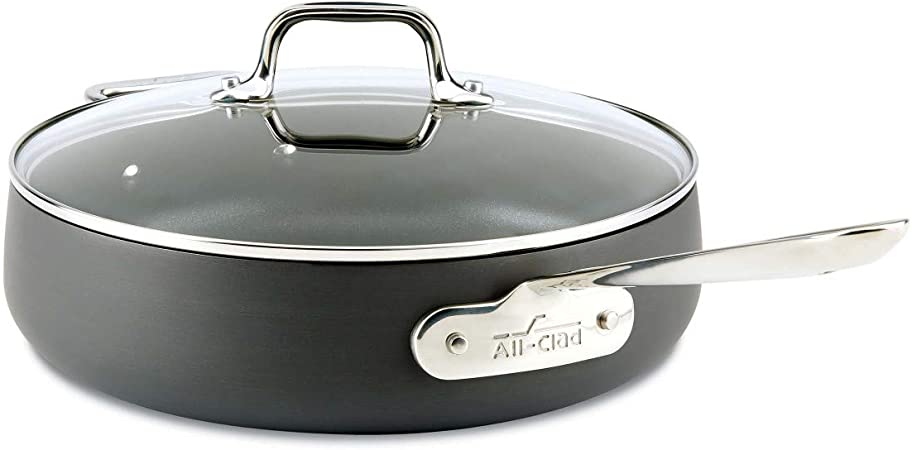
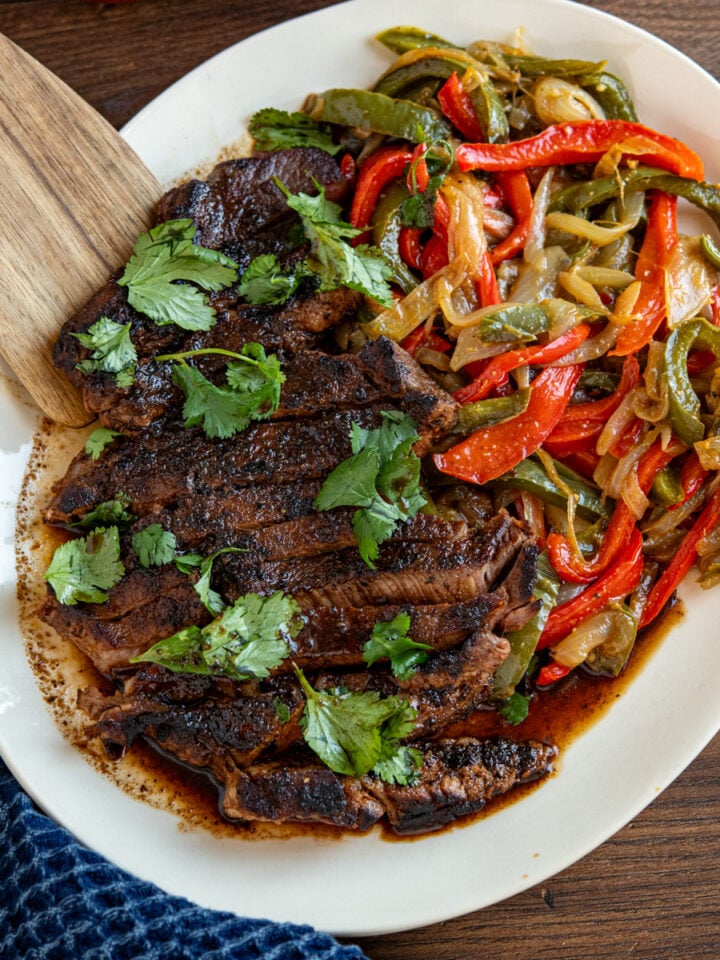
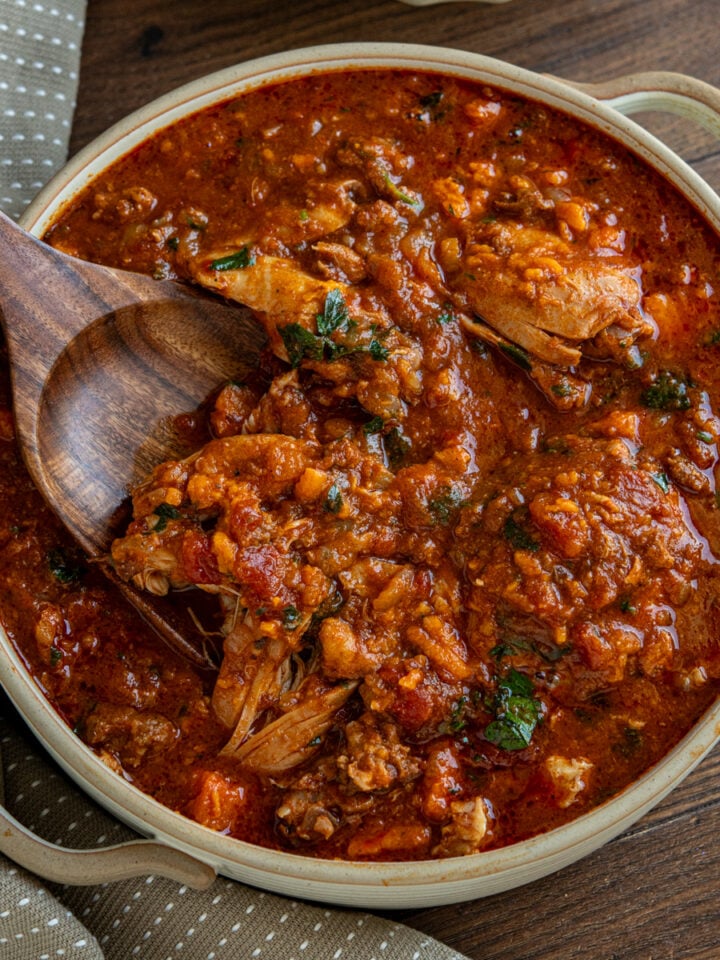
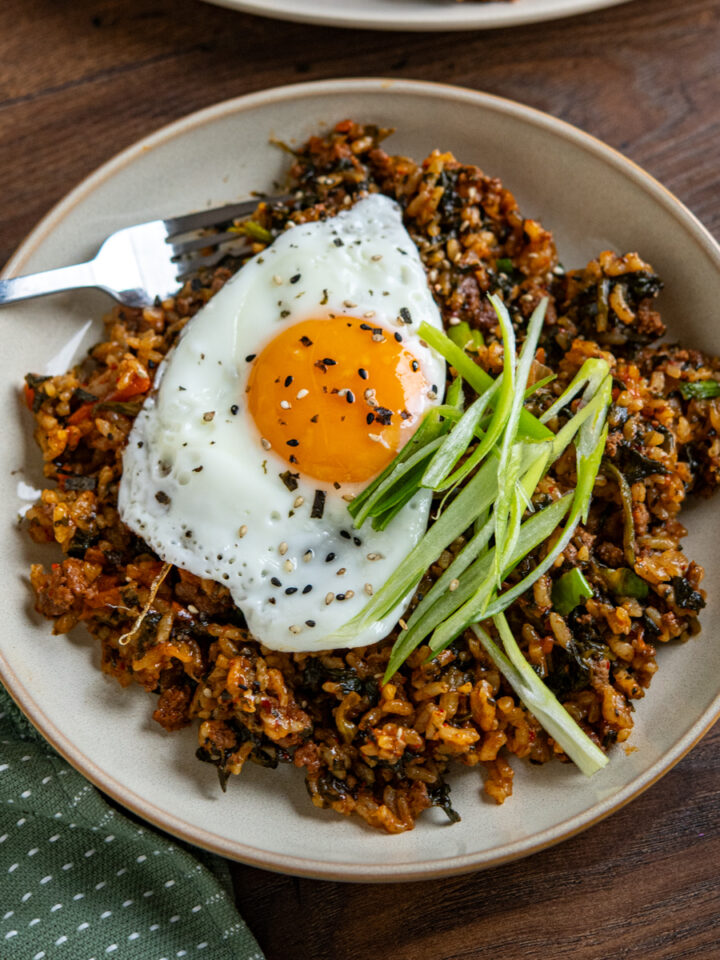

Leave a Reply